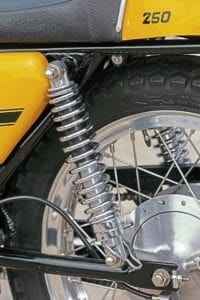Words by OliPhotography by Chippy (Mrs Doubtfire) Wood
DESMO IS A word that means everything to Ducati aficionados.
It’s the thing that makes Ducati’s engines special. Born out of their racing programme, Ducati’s Desmodromic valve actuation system, has valves that are both opened and closed by cam followers, rather than relying on coiled springs.
The advantage of Desmo valves is that at high revs the valve actuation stays much more precise and prevents valve float, allowing for a much tighter valve overlap.
Desmodromics were not a Ducati invention. Designers had been dabbling with the idea since 1889 when Daimler-Benz patented a Desmo-type system. Versions were made by JAP, Mercedes, Norton and MV Agusta.

But it was Ducati that built the first mass-market engine using Desmodromic principles. The first Ducati Desmo engine arrived in 1956 when a 125 with Desmo valve operation won the Swedish Grand Prix.
There followed 10 years of development of the Desmo engine by Ducati’s design genius Fabio Taglioni on the track, which was where most of the hunt for speed took place in the Fifties and Sixties.
In 1967 Ducati launched the wide-case single, first on the track as the 250 and 350 Sport Corsa Desmo or SCD incorporating the new crankcase design, while the road model was launched in 1968. Then, in 1969 road versions finally arrived in the showrooms.

The engine was dubbed the wide case because the front rear of the crankcases had been widened to fit a wider front and rear frame loop.
Wide case engines had a vertically split aluminium crankcase with the cylinder slightly inclined, by 10º. The camshaft was driven by a shaft using straight cut bevel gears from the crankshaft.
Fabio Taglioni and his team took the opportunity afforded by the redesign to incorporate a stronger connecting rod and big-end bearing and to increase the capacity of the lubrication system.
There was a wet sump, the increased crankcase space reducing the chances of oil leaks, with the five-speed gearbox integrated in the crankcase that held a wet clutch.

The single-down tube tubular steel frame used the engine as a stressed member, with no lower frame rails.
Read more and view more images in the July 2019 issue of CBG – on sale now!




